The Intel SSD 670p (2TB) Review: Improving QLC, But Crazy Pricing?!?
by Billy Tallis on March 1, 2021 12:00 PM ESTMixed IO Performance
For details on our mixed IO tests, please see the overview of our 2021 Consumer SSD Benchmark Suite.
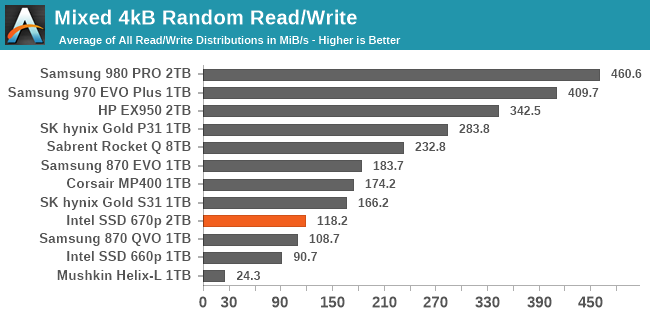 |
|||||||||
| Mixed Random IO | Performance | Efficiency | |||||||
| Mixed Sequential IO | Performance | Efficiency | |||||||
The mixed random IO test is still a significant weakness for the Intel SSD 670p; it's clearly faster than the 660p, but still far slower than either of the Phison E12-based QLC SSDs shown here (Corsair MP400, Sabrent Rocket Q). Power efficiency is consequently also poor, and the 670p falls behind even the slower Samsung 870 QVO; at least when Samsung's SATA QLC drive is being so slow, it's not using much power.
The mixed sequential IO test is a very different story: the 670p's overall performance is competitive with mainstream TLC SSDs, and even slightly higher than the HP EX950 with the SM2262EN controller. Power efficiency is also decent in this case.
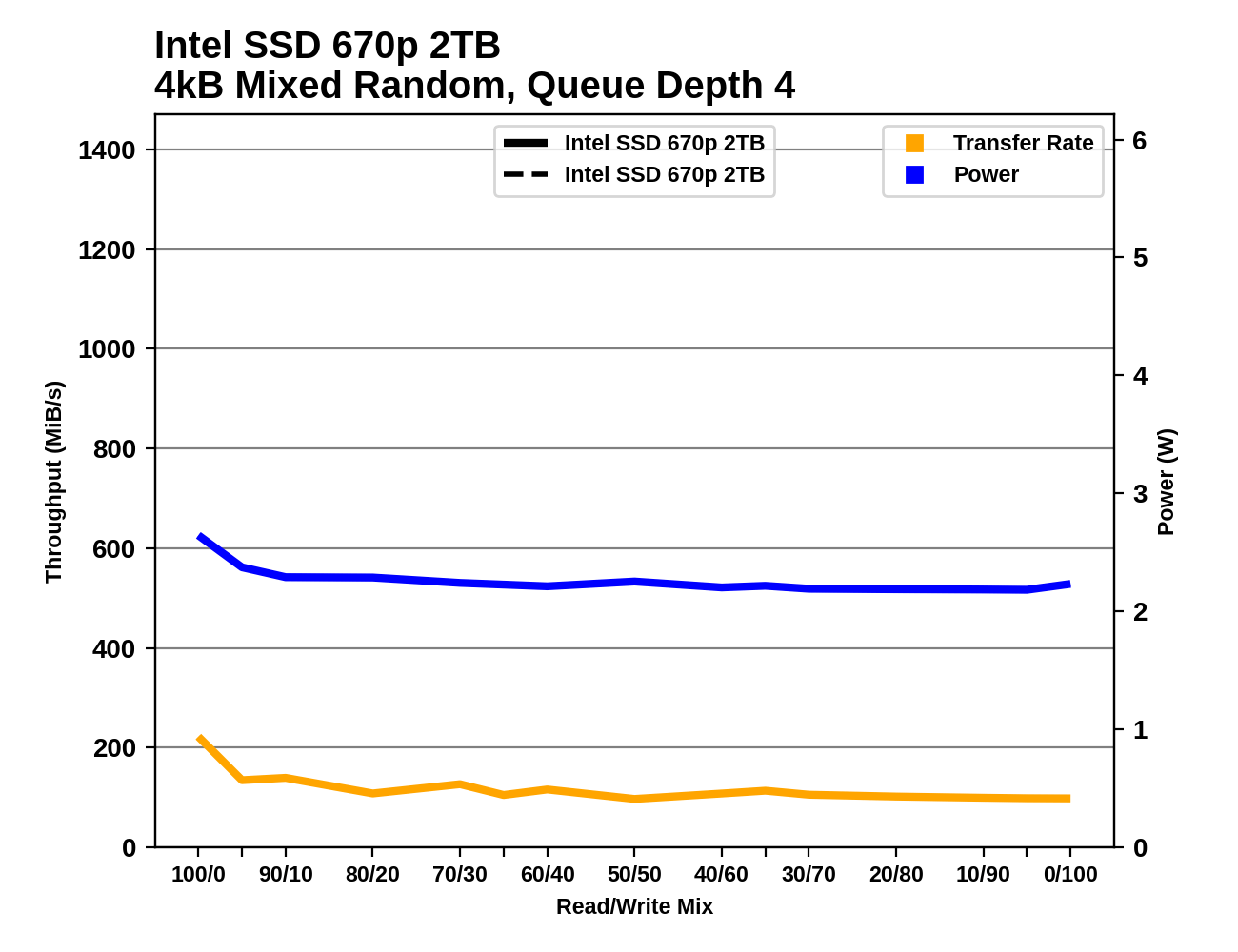 |
|||||||||
| Mixed Random IO | |||||||||
| Mixed Sequential IO | |||||||||
The Intel 670p's performance across the mixed random IO test isn't quite as steady as the 660p, but there's still not much variation and only a slight overall downward trend in performance as the workload shifts to be more write-heavy. On the mixed sequential IO test the 670p shows a few drops where SLC cache space apparently started running low, through most of the test the 670p maintains a higher throughput than the 660p could deliver for any workload even under ideal conditions.
Power Management Features
Real-world client storage workloads leave SSDs idle most of the time, so the active power measurements presented earlier in this review only account for a small part of what determines a drive's suitability for battery-powered use. Especially under light use, the power efficiency of a SSD is determined mostly be how well it can save power when idle.
For many NVMe SSDs, the closely related matter of thermal management can also be important. M.2 SSDs can concentrate a lot of power in a very small space. They may also be used in locations with high ambient temperatures and poor cooling, such as tucked under a GPU on a desktop motherboard, or in a poorly-ventilated notebook.
| Intel SSD 670p 2TB NVMe Power and Thermal Management Features |
|||
| Controller | Silicon Motion SM2265G | ||
| Firmware | 002C | ||
| NVMe Version |
Feature | Status | |
| 1.0 | Number of operational (active) power states | 3 | |
| 1.1 | Number of non-operational (idle) power states | 2 | |
| Autonomous Power State Transition (APST) | Supported | ||
| 1.2 | Warning Temperature | 77 °C | |
| Critical Temperature | 80 °C | ||
| 1.3 | Host Controlled Thermal Management | Supported | |
| Non-Operational Power State Permissive Mode | Supported | ||
The Intel 670p supports the usual range of power and thermal management features. The only oddity is the exit latency listed for waking up from the deepest idle power state: 11.999 milliseconds sounds like the drive is trying to stay under some arbitrary threshold. This might be an attempt to work around the behavior of some operating system's NVMe driver and its default latency tolerance settings.
| Intel SSD 670p 2TB NVMe Power States |
|||||
| Controller | Silicon Motion SM2265 | ||||
| Firmware | 002C | ||||
| Power State |
Maximum Power |
Active/Idle | Entry Latency |
Exit Latency |
|
| PS 0 | 5.5 W | Active | - | - | |
| PS 1 | 3.6 W | Active | - | - | |
| PS 2 | 2.6 W | Active | - | - | |
| PS 3 | 25 mW | Idle | 5 ms | 5 ms | |
| PS 4 | 4 mW | Idle | 3 ms | 11.999 ms (?!) | |
Note that the above tables reflect only the information provided by the drive to the OS. The power and latency numbers are often very conservative estimates, but they are what the OS uses to determine which idle states to use and how long to wait before dropping to a deeper idle state.
Idle Power Measurement
SATA SSDs are tested with SATA link power management disabled to measure their active idle power draw, and with it enabled for the deeper idle power consumption score and the idle wake-up latency test. Our testbed, like any ordinary desktop system, cannot trigger the deepest DevSleep idle state.
Idle power management for NVMe SSDs is far more complicated than for SATA SSDs. NVMe SSDs can support several different idle power states, and through the Autonomous Power State Transition (APST) feature the operating system can set a drive's policy for when to drop down to a lower power state. There is typically a tradeoff in that lower-power states take longer to enter and wake up from, so the choice about what power states to use may differ for desktop and notebooks, and depending on which NVMe driver is in use. Additionally, there are multiple degrees of PCIe link power savings possible through Active State Power Management (APSM).
We report three idle power measurements. Active idle is representative of a typical desktop, where none of the advanced PCIe link or NVMe power saving features are enabled and the drive is immediately ready to process new commands. Our Desktop Idle number represents what can usually be expected from a desktop system that is configured to enable SATA link power management, PCIe ASPM and NVMe APST, but where the lowest PCIe L1.2 link power states are not available. The Laptop Idle number represents the maximum power savings possible with all the NVMe and PCIe power management features in use—usually the default for a battery-powered system but rarely achievable on a desktop even after changing BIOS and OS settings. Since we don't have a way to enable SATA DevSleep on any of our testbeds, SATA drives are omitted from the Laptop Idle charts.
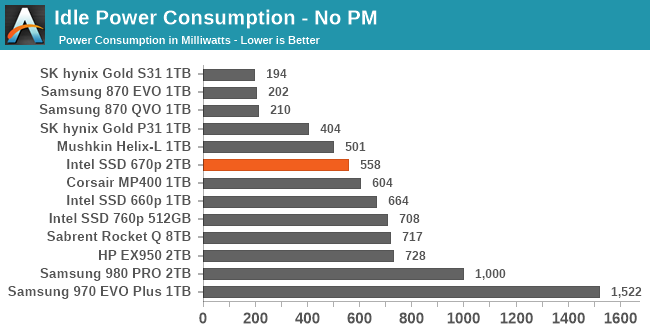
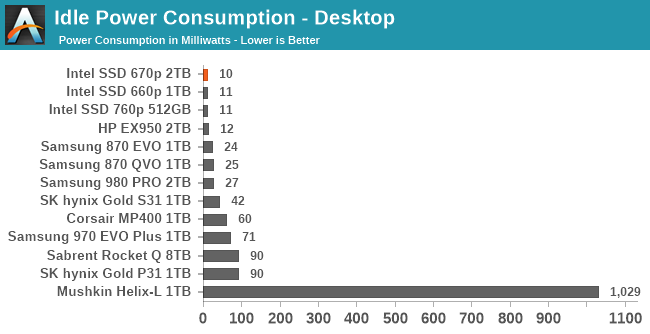
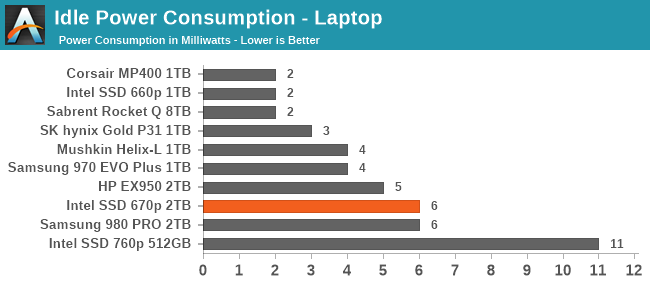
The active idle power of the 670p is clearly lower than the 660p with the SM2263 controller, but not quite as low as the Mushkin Helix-L with the DRAMless SM2263XT. So Silicon Motion has made some power optimizations with the SM2265, but it's still not in the same league as the controller SK hynix built for the Gold P31.
The desktop and laptop idle states we test have appropriately low power draw. However, when activating the laptop idle configuration (PCIe ASPM L1.2) the 670p would crash and not wake up from idle. This kind of bug is not unheard-of (especially with other Silicon Motion NVMe controllers), and the Linux NVMe driver has a list of drives that can't be trusted to work properly with their deepest idle power state enabled. Sometimes this can be narrowed down to a particular host system configuration or specific SSD firmware versions. But until now, this particular machine hasn't run into crashes with idle power modes on any of the drives we've tested, which is why we've trusted it as a good proxy for the power management behavior that can be expected from a properly-configured laptop. It's disappointing to see this problem show up once again with a new controller where the host system is almost certainly not at fault. Hopefully Intel can quickly fix this with a new firmware version.











72 Comments
View All Comments
abufrejoval - Monday, March 1, 2021 - link
This is the kind of article, that keeps AT at the top of my daily reading list.While it's technically very neutral and to the point the last paragraph almost sound a bit like good old Charly Demerjan from Semiaccurate, who barely seems to peekt out behind his self-inflicted pay wall any more.
Nice job and I know why my last Intel SSD was a Postville, still running btw.
Hifihedgehog - Monday, March 1, 2021 - link
The interwebs gifted us the nickname of Faillake to describe Skylake, but have they come up yet with a clever name to adequately describe this pricing disaster? QLC-quandry? QLC-quagmire? I honestly don't know who would buy these except for the engineering team and the most ardent fanboys. By the way, the fanboys are very ticked off today by Billy Talis' extremely honest assessment and are downvoting other people as well who are calling the pricing "horrendous."Great_Scott - Tuesday, March 2, 2021 - link
Looks like AT is alone in talking about the pricing. I typically like HH, but they are way off base on that aspect of their review. That was a bummer to discover.A5 - Monday, March 1, 2021 - link
The conclusion here is bang-on. This is a pretty good QLC drive at a terrible price. It needs to be 10 or 11 cents/GB to be a winner.Glock24 - Monday, March 1, 2021 - link
That's more expensive than some good TLC drives 🤷🏻♂️powerarmour - Monday, March 1, 2021 - link
I refuse out of principle to ever purchase a QLC drive.Small Bison - Monday, March 1, 2021 - link
And for this particular drive, it doesn't take much principle to buy a better-performing TLC SSD for less money.Reflex - Monday, March 1, 2021 - link
I remember when everyone said this about TLC, yet here we are...JimmyZeng - Tuesday, March 2, 2021 - link
But for TLC this phase is much shorter, QLC is around for quite a few years, yet it failed to catch on, yeah 670 is crazily priced, but even with 660/665, they never showed any pricing advantage comparing to TLC competitors, I suppose the (rough) theoretical upper limit of 33%(4bpc/3bpc) capacity/price ratio improvement of QLC over TLC is at play here.utferris - Tuesday, March 2, 2021 - link
Learn some math before posting something.QLC (4 bit) is double the size of TLC (3 bit), not 4/3.
So theoretically, the same QLC flash can double the capacity than it is used as TLC. Although in reality, the cost of QLC can not go down to half of TLC, but it should be able to get close in the long run.